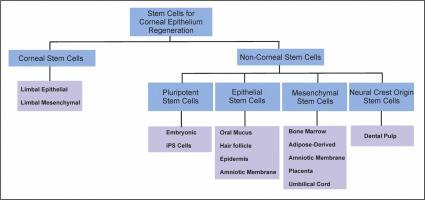Tissue & Cell ( IF 2.6 ) Pub Date : 2020-11-19 , DOI: 10.1016/j.tice.2020.101470 Hamed Nosrati 1 , Zohreh Alizadeh 2 , Ali Nosrati 3 , Korosh Ashrafi-Dehkordi 4 , Mehdi Banitalebi-Dehkordi 4 , Samira Sanami 5 , Mohammad Khodaei 6

|
Any significant loss of vision or blindness caused by corneal damages is referred to as corneal blindness. Corneal blindness is the fourth most common cause of blindness worldwide, representing more than 5% of the total blind population. Currently, corneal transplantation is used to treat many corneal diseases. In some cases, implantation of artificial cornea (keratoprosthesis) is suggested after a patient has had a donor corneal transplant failure. The shortage of donors and the side effects of keratoprosthesis are limiting these approaches. Recently, researchers have been actively pursuing new approaches for corneal regeneration because of these limitations. Nowadays, tissue engineering of different corneal layers (epithelium, stroma, endothelium, or full thickness tissue) is a promising approach that has attracted a great deal of interest from researchers and focuses on regenerative strategies using different cell sources and biomaterials. Various sources of corneal and non-corneal stem cells have shown significant advantages for corneal epithelium regeneration applications. Pluripotent stem cells (embryonic stem cells and iPS cells), epithelial stem cells (derived from oral mucus, amniotic membrane, epidermis and hair follicle), mesenchymal stem cells (bone marrow, adipose-derived, amniotic membrane, placenta, umbilical cord), and neural crest origin stem cells (dental pulp stem cells) are the most promising sources in this regard. These cells could also be used in combination with natural or synthetic scaffolds to improve the efficacy of the therapeutic approach. As the ocular surface is exposed to external damage, the number of studies on regeneration of the corneal epithelium is rising. In this paper, we reviewed the stem cell-based strategies for corneal epithelium regeneration.
中文翻译:

基于干细胞的角膜上皮再生治疗策略
由角膜损伤引起的任何显着的视力丧失或失明都称为角膜失明。角膜失明是全球第四大最常见的失明原因,占盲人总数的 5% 以上。目前,角膜移植用于治疗多种角膜疾病。在某些情况下,建议在患者的供体角膜移植失败后植入人工角膜(角膜假体)。供体短缺和角膜假体的副作用限制了这些方法。最近,由于这些限制,研究人员一直在积极寻求角膜再生的新方法。如今,不同角膜层(上皮、基质、内皮、或全厚度组织)是一种很有前途的方法,它引起了研究人员的极大兴趣,并专注于使用不同细胞来源和生物材料的再生策略。角膜和非角膜干细胞的各种来源在角膜上皮再生应用中显示出显着优势。多能干细胞(胚胎干细胞和 iPS 细胞)、上皮干细胞(来源于口腔粘液、羊膜、表皮和毛囊)、间充质干细胞(骨髓、脂肪来源、羊膜、胎盘、脐带),和神经嵴起源干细胞(牙髓干细胞)是这方面最有希望的来源。这些细胞也可以与天然或合成支架结合使用,以提高治疗方法的功效。随着眼表暴露于外部损伤,关于角膜上皮再生的研究数量不断增加。在本文中,我们回顾了基于干细胞的角膜上皮再生策略。


























 京公网安备 11010802027423号
京公网安备 11010802027423号